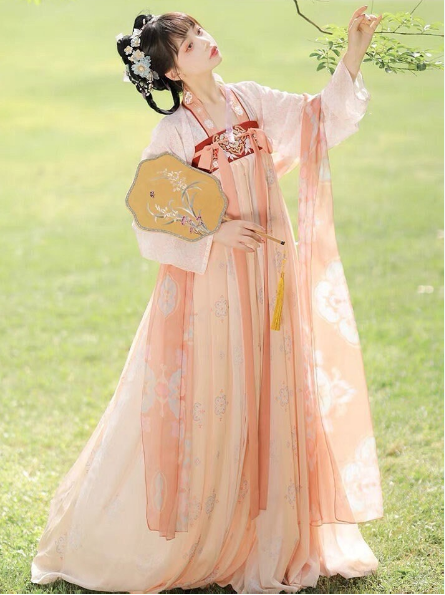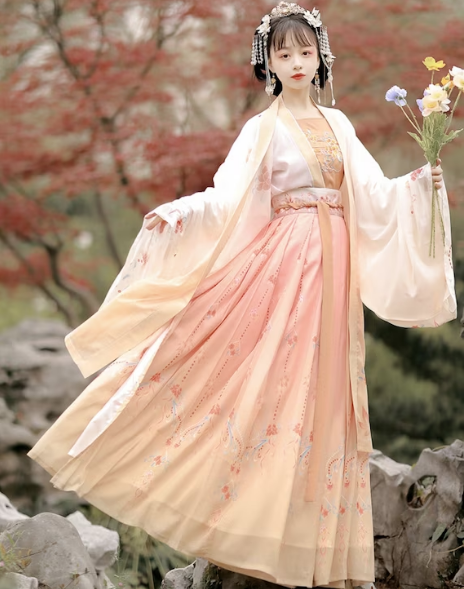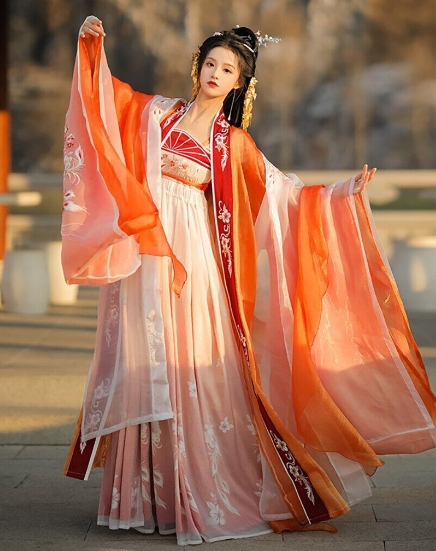Hanfu represents a significant aspect of Chinese cultural identity, though not officially designated as a national costume.
Historical Origins of Hanfu
The history of Hanfu traces its roots to the early dynastic periods of China. Originating during the Huangdi era, this traditional attire symbolizes the sartorial elegance of ancient Chinese culture. Hanfu notably evolved through various dynasties, each adding unique elements and styles.
The Evolution of Hanfu Through Dynasties
Hanfu witnessed significant transformations across different Chinese dynasties. In the Shang Dynasty, it primarily consisted of simple tunics and skirts. The Zhou Dynasty introduced cross-collar garments, refining the style and elegance of Hanfu. The Han Dynasty, from which Hanfu derives its name, saw the inclusion of wider sleeves and flowing robes, adding a sense of majesty to the attire. Subsequent dynasties, like the Tang, Song, and Ming, each contributed to the evolution of Hanfu, introducing vibrant colors, intricate patterns, and varied fabrics.

Hanfu in Ancient Rituals and Ceremonies
In ancient China, Hanfu played a crucial role in rituals and ceremonies. It was not just clothing but a symbol of cultural identity and social status. During the Zhou Dynasty, for example, Hanfu’s design strictly adhered to social hierarchies and ceremonial importance. The colors, patterns, and accessories of Hanfu were meticulously chosen based on the occasion, be it royal ceremonies, religious rituals, or cultural festivals. This ceremonial usage of Hanfu underlines its deep-seated significance in the rich tapestry of Chinese history.
In crafting this attire, artisans often employed silk, a material highly regarded for its quality and elegance. Silk’s prominence in Hanfu underscores China’s ancient mastery in silk production, a craft that significantly influenced global trade and cultural exchanges along the Silk Road.
Hanfu’s historical evolution reflects China’s artistic and cultural dynamism, with each dynasty infusing new life into this iconic garment. The enduring legacy of Hanfu, still visible in contemporary fashion, speaks volumes about its timeless appeal and cultural significance.
Cultural Significance of Hanfu
Hanfu stands as a powerful emblem of Chinese cultural identity. Its designs, evolving over centuries, encapsulate the philosophical and aesthetic ideals of China. Hanfu is not just a garment; it’s a vibrant expression of Chinese history, values, and traditions.
Symbolism in Hanfu Designs
The designs of Hanfu are rich in symbolism and meaning. Colors in Hanfu often carry significant connotations. For instance, red, frequently used in Hanfu, symbolizes good fortune and joy, while blue represents serenity and virtue. Dragons and phoenixes, commonly embroidered on Hanfu, denote power, nobility, and prosperity. The use of these symbols in Hanfu reflects the deep-seated beliefs and values of Chinese culture.
Hanfu’s Role in Traditional Chinese Festivals
During traditional Chinese festivals, Hanfu plays a central role in the celebrations. In the Spring Festival, people often wear Hanfu to symbolize a fresh start and to honor their ancestors. During the Mid-Autumn Festival, Hanfu becomes a part of the festivities, reflecting the harmony and unity of families. The elegance and grace of Hanfu add to the festive atmosphere, connecting the present with the rich tapestry of China’s past.
The intricate craftsmanship of Hanfu, often using high-quality materials like silk, highlights the garment’s importance in Chinese culture. The use of silk, not only adds to the beauty of Hanfu but also showcases China’s historical prowess in silk production.
Through its continued presence in festivals and celebrations, Hanfu remains a living testament to the enduring legacy of Chinese culture and tradition. Its role in these festivities is not merely about wearing a costume; it’s about rekindling a connection with a heritage that spans millennia.
Hanfu in Modern Society
In modern society, Hanfu transcends its historical roots, emerging as a symbol of cultural pride and identity. Younger generations especially embrace it, blending tradition with modern fashion sensibilities.
The Hanfu Revival Movement
The Hanfu Revival Movement, gaining momentum in the early 21st century, plays a pivotal role in reintroducing this traditional attire. It’s not just a fashion statement but a movement steeped in cultural rediscovery and national identity. Enthusiasts, through social media and Hanfu events, are spearheading this resurgence, showcasing Hanfu’s elegance and diversity to a global audience.
Hanfu’s Influence on Contemporary Fashion
Hanfu’s influence on contemporary fashion is unmistakable. Designers draw inspiration from its flowing silhouettes, intricate patterns, and vibrant colors. This fusion of ancient elegance with modern style creates unique fashion statements. Hanfu-inspired apparel often features in high-end fashion shows, reflecting a growing appreciation of traditional Chinese aesthetics in global fashion.
The quality and craftsmanship of modern Hanfu, often using luxurious fabrics and detailed embroidery, indicate its rising status in the fashion industry. This blend of traditional design and modern techniques results in garments that are both culturally significant and fashionable.
Through events like the Hanfu Movement, this traditional attire is gaining a new lease of life, bridging the gap between China’s rich past and its dynamic present. Hanfu in modern society is more than a nod to history; it’s a living, evolving form of cultural expression.
Comparison with Other National Costumes
Hanfu’s unique style and history provide a fascinating contrast to other national costumes. These comparisons highlight the rich diversity in traditional attire globally.
Differences Between Hanfu and Japanese Kimono
The Hanfu and the Japanese Kimono exhibit distinct characteristics, reflecting their cultural origins. Hanfu, typically made of flowing layers, emphasizes loose fits and straight cuts, often featuring cross collars and wide sleeves. In contrast, the Kimono, known for its T-shaped design, is characterized by its wrap-around style, obi belt, and more subdued color palette compared to the often vibrant Hanfu. These differences not only illustrate variations in aesthetics but also the differing cultural values and histories of China and Japan.

Similarities with Korean Hanbok
Despite differences, Hanfu shares similarities with the Korean Hanbok, particularly in their historical roots and symbolic significance. Both costumes showcase elegance through simple, flowing lines. The Hanbok, like Hanfu, often uses bright colors and is worn during important festivals and celebrations. These similarities reflect the shared cultural heritage and historical interactions between Korea and China.
The materials used in both Hanfu and Hanbok, predominantly silk and cotton, demonstrate a mutual appreciation for high-quality, natural fabrics. The choice of these materials not only contributes to the beauty and comfort of the garments but also signifies the wearer’s status and cultural identity.
Exploring the nuances of Hanfu in comparison with other national costumes like the Kimono and Hanbok offers insights into the broader context of East Asian traditional attire. These garments, while unique to their cultures, share a common thread of representing the rich history and identity of their respective nations.
Challenges and Controversies
The journey of Hanfu in the modern era is not without its challenges and controversies. These issues are pivotal in understanding the complex dynamics surrounding this traditional attire.
Debates Over Hanfu as a National Symbol
Hanfu’s resurgence has sparked debates about its status as a national symbol. Some view Hanfu as a pure representation of Chinese cultural identity, advocating for its broader adoption and official recognition. Others argue that such a move might overlook the diverse ethnic and cultural tapestries within China. This debate is not merely about clothing but touches on broader themes of national identity, cultural homogenization, and the representation of historical accuracy.
The Impact of Globalization on Hanfu Preservation
Globalization presents both opportunities and challenges for Hanfu preservation. While it has aided in popularizing Hanfu globally, there are concerns about the dilution of its traditional essence. The commercialization of Hanfu often leads to modifications that stray from historical accuracy for broader appeal. This tension between maintaining authenticity and adapting to contemporary tastes is a key challenge in preserving the cultural integrity of Hanfu.
The cost and quality of authentic Hanfu can also be a concern. Traditional Hanfu requires skilled craftsmanship and high-quality materials, often increasing the price, which can limit accessibility. Balancing affordability while maintaining the quality and cultural significance of Hanfu is another challenge posed by globalization.
Exploring the debates and impacts surrounding Hanfu highlights the complexities in preserving and promoting traditional attire in a rapidly globalizing world. These discussions are crucial in shaping the future trajectory of Hanfu, ensuring it remains a vibrant and meaningful symbol of Chinese culture.

Future of Hanfu
The future of Hanfu looks promising, evolving in ways that intertwine tradition with modernity. This evolution plays a crucial role in its enduring relevance and appeal.
Integrating Hanfu into Modern Wardrobe
Integrating Hanfu into the modern wardrobe is a trend gaining momentum. Designers are creatively adapting Hanfu, making it more suitable for everyday wear while retaining its traditional essence. This integration involves simplifying designs, introducing new materials, and incorporating elements of Hanfu into contemporary fashion. Such adaptations make Hanfu more accessible and appealing to a broader audience, ensuring its relevance in the modern fashion landscape.
Hanfu’s Role in Cultural Diplomacy and Global Perception
Hanfu also plays a significant role in cultural diplomacy and shaping global perceptions of Chinese culture. As an emblem of China’s rich heritage, Hanfu showcases the country’s history and traditions on the international stage. Through cultural exchanges, exhibitions, and fashion shows, Hanfu offers a medium for cross-cultural understanding and appreciation. Its role in global events helps in promoting a nuanced view of Chinese culture, beyond the often stereotypical representations.
The quality of Hanfu, in terms of fabric and craftsmanship, remains a key focus, even as it adapts to modern styles. Maintaining high standards in these aspects is crucial for preserving its authenticity and appeal in the global arena.
As Hanfu continues to evolve, it holds the potential to become not just a national symbol but also a global fashion phenomenon. The journey of Hanfu into the future is one of balancing tradition with innovation, ensuring that it remains a vibrant and meaningful part of both Chinese and global culture.







